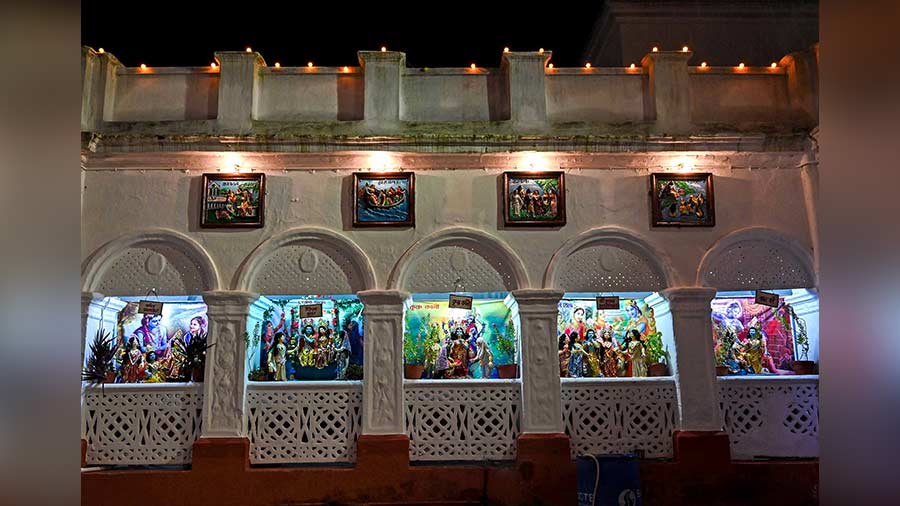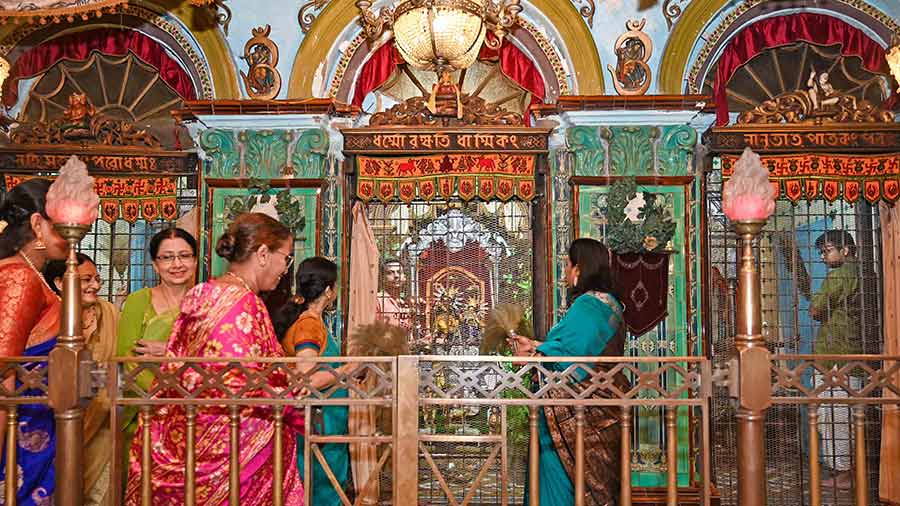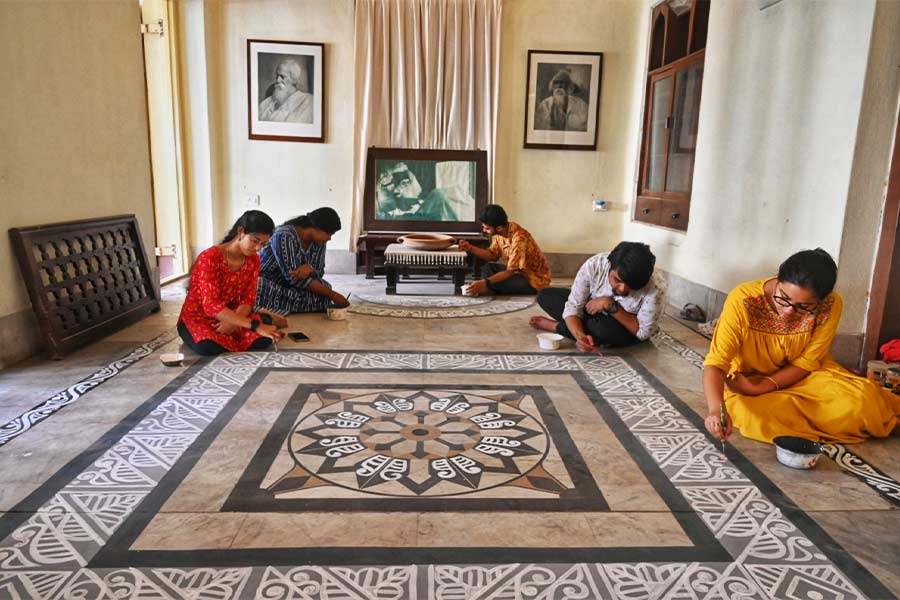A thakurdalan with a chandelier hanging from the ceiling decorated with intricate marble work, elaborate aarti rituals on five evenings followed by classical music programmes — Jhulan Yatra at Adhikary Bari in Bowbazar is a grand affair.
Jhulan Yatra — the festival of swings — continues to be celebrated with great pomp and grandeur in some bonedi baris of central and north Kolkata. The festival is celebrated every year in the month of Sraabon — between July and August.
Kirtan, music, dance and jatrapala mark the five-day celebrations besides the puja rituals. My Kolkata visited a few households where the tradition of Jhulan Yatra lives on.
Jhulanbari of Ramkanai Adhikary, Bowbazar

The red-coloured Jhulanbari on Baburam Sil Lane
Amit Datta/My KolkataBaburam Sil Lane is actually a bylane that branches out of Sashibhusan Dey Street at a point where Ramkanai Adhikary Lane ends. The ancestral house of the Adhikarys could be seen on one side of the lane and their thakurdalan on the other.
This house, locally known as Rambabur bari or laal bari, holds Jhulan Yatra for almost two centuries. Krishnamohan Adhikary, a Sree Chaitanya disciple who came to Kolkata from Burdwan, built the thakurdalan and started the festival.
Ramkanai Adhikary, a descendant of Krishnamohan, was popular in the area for his involvement in charitable and social activities. He developed the thakurdalan with marble works and started holding classical music soirees there from 1875.
“Krishnamohan Adhikary came to Kolkata in the 18th century and built the thakurdalan. Back then, it was not as beautifully decorated as you see it today. It took a few years for Ramkanai Adhikary to beautify it with marbles,” said Ratnaboli Adhikary, a seventh-generation member of the family.

The decorated ceiling and the great chandelier of Adhikary Bari
Amit Datta/My KolkataRadha-Krishna idols are placed in the sanctum sanctorum inside the thakurdalan. Before them are set Jagannath-Laxmi idols on the left and Gour-Nitai idols on the right. The idol of Krishna is made of koshtipathor (touchstone), while the idol of Radha is made of astadhatu, an amalgamation of eight alloys. Beautifully decorated with a chandelier, the ceiling shows intricate marble designs decorated with different types of carvings.
“The celebration was grander in our childhood. Even now the deities are dressed in different costumes or besh on each day of Jhulan Yatra. The deities are dressed in rakhal besh on the very first day, jogi besh on the second day, Subal besh on the third day, kotal besh on the fourth day and raj besh on the final day of the festival,” explained Utpal Adhikary, another member of the family.
Classical music programmes are held every year on the thakurdalan after the evening aarti on all five days of Jhulan Yatra. Musical stalwarts like Joykrishna Sanyal, Radhika Prasad Goswami, VG Jog, Aghore Chakraborty, Shyamal Bose and Rashid Ali Khan performed here over the years on the occasion of Jhulan Yatra.

Classical music performance by Dwiptanil Bhattacharya (sarod) and Sujit Saha (tabla) on the thakurdalan of Adhikary Bari
Amit Datta/My Kolkata“Ramkanai Adhikary was a music connoisseur and started holding musical soirees here. At that time, Jadu Bhatta, the music teacher of Rabindranath Tagore, was a famous vocalist of Bishnupur gharana. He was Ramkanai’s peer and used to stay here during the festival. He used to perform all night, accompanied by Ramkanai on the pakhawaj,” said Utpal.
A chartered accountant by profession, Utpal himself is a trained sitar player and is in charge of organising musical evenings on the five days of Jhulan Yatra. “The family has become smaller over the years. We have become old but still try to maintain the rituals. Of course, the pujo took place during the pandemic but we had to cut down on the number of guests. I hope that our next generation will continue to uphold the tradition.”
Jhulantala, Chaltabagan

Radha-Krishna idols at Radhagobindo Jew-er Mandir
My KolkataJhulantala in Chaltabagan is popular for two of its traditional Jhulan Yatra hotspots. The first one is Radhagobindo Jew-er Jhulan Sree Mandir, which was established by Horendranath Mandal in 1938, and the other is Chaltabagan Jhulanbari, which was founded in 1925 by Bankubihari Saha.
The area is called Jhulantala because of a big fair that used to cover the entire stretch from Chaltabagan to Maniktala and a massive number of yatras that used to be held in every narrow lane. Radhagobinda Jew-er Mandir pulled more crowds with its moving figurines that were operated by motors. The entrance of the temple was grandly decorated.
However, the celebrations were toned down since the pandemic as the head of the family succumbed to Covid. The size of the fair has also reduced after the pandemic, but it still attracts a lot of people around that area. “Since then, the family has not been able to keep up with pomp. We take care of the rituals and do the bare minimum,” said a priest at the temple.

Episodes from Krishna’s life at Chaltabagan Jhulanbari
Amit Datta/My KolkataChaltabagan Jhulanbari is maintained by Saha Rajbari of Maniktala. The Saha family, who were local zamindars, have their ancestral house a stone’s throw away from the temple where Jhulan Yatra is celebrated. The temple area comprises a huge courtyard with each side decorated by idols and figurines depicting different tales from Krishna’s life. There is a fountain in the middle of the courtyard and a staircase leads to the thakurdalan.
“The temple was founded by Bankubihari Saha, who was originally a salt merchant from Allahabad. He started the Jhulan Yatra festival on the temple premises in the early 19th century. Five major festivals are now celebrated here — Dol Yatra, Rash Yatra, Jhulan Yatra, Janmashtami and Shivratri,” said Brijitbihari Saha, the only son of the family in the fifth generation.
Saha Rajbari has a thakurdalan in their main house where Durga Puja is celebrated. The puja is more than 160 years old. The family members participate in the pujas and rituals of Jhulan Yatra on all days. Three priests perform the evening aarti in the temple. Though people of north Kolkata flocked to the place to see the evening rituals, entry was limited as per the Covid guidelines during the pandemic.

Thakurdalan of Chaltabagan Jhulanbari
Amit Datta/My KolkataBrijitbihari said it had become difficult to manage everything since the family got smaller over the years. “Most of our family members are outside the country or Bengal. Only a few of us are now involved in the arrangements. We try our best to keep up. That’s why we can’t hold yatrapalas on the temple premises anymore. But we are still putting up shong. The Radha-Krishna idols are dressed up in new costumes every day of Jhulan Yatra and sandhya aarti is held in the evening.”






